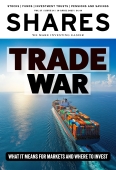Archived article
Please note that tax, investment, pension and ISA rules can change and the information and any views contained in this article may now be inaccurate.
Why selling in a panic has always proved a mistake

Since I started writing about markets nearly 20 years ago there have been two really big sell-offs, the first early on in my fledgling career as the global financial crisis hit in 2007 and the second a little over five years ago as the Covid pandemic struck.
In between, there have been periods of pretty intense market weakness and stocks in some parts of the world have really suffered but, for developed markets, those two episodes stand alone.
Right now it’s just too early to say where the current tariff-inspired selling will rank, though it has the feel of being significant.
In a News special on the correction, my deputy Ian Conway, who has substantially more experience than me, looks at the long-term context and Martin Gamble examines how different asset classes have been performing.
Judging exactly where and when markets will settle is very tricky and that is the key reason why it better to stay invested through periods volatility. There’s some research from BlackRock that I always reach for during tricky spells for stocks.
Updated on an annual basis, the asset manager’s latest such exercise found if you had invested $10,000 in the S&P 500 on New Year’s Eve in 2004 and stayed invested right up until the 31 December 2024, then you would be sitting on $71,750.
However, if you had missed just the best five days for the market then you would have a $45,318 pot, and if you missed the best 25 days this total would have shrunk to just $15,889.
Crucially, most of the market’s best days follow soon after their worst and occur during periods when market conditions are febrile.
In other words, selling when the market is in panic mode has proved to be a very expensive mistake in the past.
As the table shows, even if you had been spectacularly unlucky and invested just before the market experienced one of its big crashes of the last century then ultimately you would have seen the value of your investment grow if you had remained invested for the long term.
Admittedly, in the case of the Great Depression and tech bubble, you would have needed to be very patient.
Our main feature this week details the benefits of regular investment at times like these while looking at the sectors which have been most resilient in previous drawdowns and highlighting areas which could offer some protection.
Obviously if you are close to needing to draw from your investment pot then the calculus is rather different. We will take a look at this topic in more detail in an upcoming issue.
Important information:
These articles are provided by Shares magazine which is published by AJ Bell Media, a part of AJ Bell. Shares is not written by AJ Bell.
Shares is provided for your general information and use and is not a personal recommendation to invest. It is not intended to be relied upon by you in making or not making any investment decisions. The investments referred to in these articles will not be suitable for all investors. If in doubt please seek appropriate independent financial advice.
Investors acting on the information in these articles do so at their own risk and AJ Bell Media and its staff do not accept liability for losses suffered by investors as a result of their investment decisions.
 magazine
magazine








